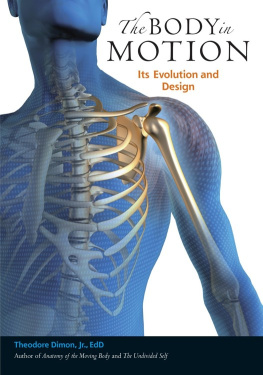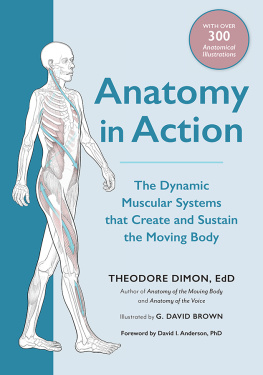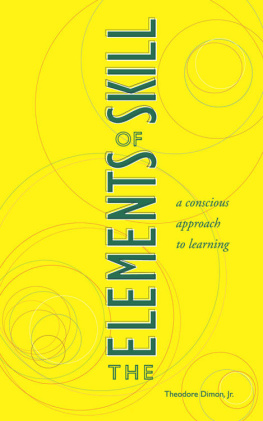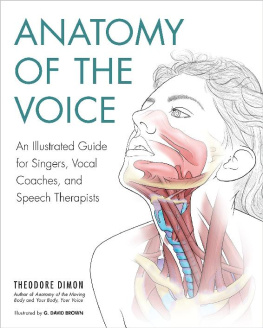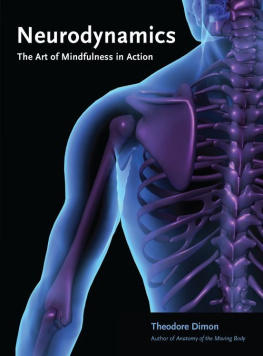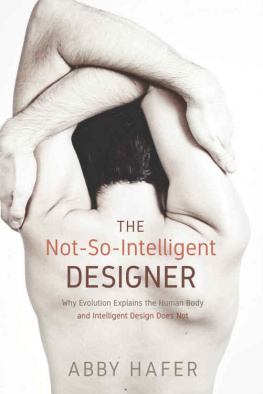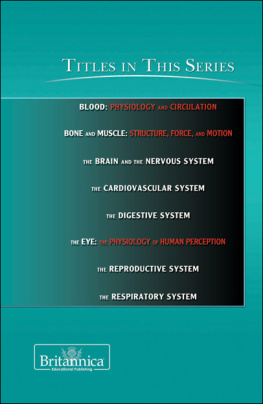Other books by Theodore Dimon, Jr.
The Elements of Skill:
A Conscious Approach to Learning
The Undivided Self:
Alexander Technique and the Control of Stress
Anatomy of the Moving Body, Second Edition:
A Basic Course in Bones, Muscles, and Joints
Your Body, Your Voice:
The Key to Natural Singing and Speaking
Copyright 2011 by Theodore Dimon, Jr. All rights reserved. No portion of this book, except for brief review, may be reproduced, stored in a retrieval system, or transmitted in any form or by any meanselectronic, mechanical, photocopying, recording, or otherwisewithout the written permission of the publisher. For information contact North Atlantic Books.
Published by
North Atlantic Books
P.O. Box 12327
Berkeley, California 94712
Cover art iStockphoto.com/Comotion Design
Cover design by Brad Greene
Illustrations by G. David Brown
The Body in Motion: Its Evolution and Design is sponsored by the Society for the Study of Native Arts and Sciences, a nonprofit educational corporation whose goals are to develop an educational and cross-cultural perspective linking various scientific, social, and artistic fields; to nurture a holistic view of arts, sciences, humanities, and healing; and to publish and distribute literature on the relationship of mind, body, and nature.
North Atlantic Books publications are available through most bookstores. For further information, visit our website at www.northatlanticbooks.com or call 800-733-3000.
The Library of Congress has cataloged the printed edition as follows:
Dimon, Theodore.
The body in motion : its evolution and design / Theodore Dimon Jr.
p.; cm.
eISBN: 978-1-58394-691-6
1. Musculoskeletal systemAnatomy. 2. Musculoskeletal systemEvolution. 3. Human locomotion. 4. Human locomotion. I. Title.
[DNLM: 1. Musculoskeletal Systemanatomy & histology. 2. Biomechanics.
3. Movement. 4. Musculoskeletal Physiological Phenomena. WE 101 D582b 2010]
QM100.D563 2010
611.7dc22
2010021590
v3.1
To Walter Carrington, with gratitude and appreciation
Contents
Illustrations
A primitive fish (amphioxus)
Lateral flexion in a fish
Early amphibians coming onto land
Extensors of trunk and legs
Diagram showing where muscles are needed to keep a structure from falling down
Extensor muscles of the back: a. deep postural muscles; b. erector spinae
Muscles on front of spine that support the cervical and lumbar curves
Forward balance of the skull
Head balance in relation to the extensors of neck and back
The sub-occipital muscles are crucial indicators of posture and balance in the body
Head balance in a cat
Head balance in a human
Disruption of head balance
Spine as a bridge
The upright human spine
Flexor muscles on the front of the body
Flexor muscles on the front of the spine
Tent pole and guy wires
Sternocleidomastoid muscles supporting the rib cage
Backward pull of sternocleidomastoid muscle on head
Head balance
The spine
Vertebrae of the spine
Notochord and neural tube
Developing arch and body of vertebra
Evolutionary development of the spine
The thoracic curve in a four-footed animal
The balanced curves in the human spine
The shoulder girdle
Shoulder girdle with immobile socket vs. mobile socket
Muscles from entire length of spine converging into shoulder
Muscles moving the scapula
Evolution of pectoral fin to the forelimb of an early amphibian
Suspensory muscles of the shoulder girdle
Pectoral muscle attaching to coracoid process
Muscles attaching to the upper arm
Pectoralis major
Widening of the shoulder girdle
Bones of the left upper limb
Action of the hand at the wrist
Rotation of the radius around the ulna
Rotation mechanism of the forearm
Bones of the hand
Action of the lumbrical muscles
Bones and joints of the thumb
Distal joints of the thumb
Action of TM joint showing the movement of the thumb pad in relation to the hand
TM joint at base of movable column
Bones of the pelvis
Front view of the pelvis
Relationship of the pelvis to the spine in a fish and amphibian
The scapula of the pelvis transmits force to the spine
The scapula of the shoulder girdle absorbs force
Arch of pelvis transmitting weight to legs
The ischial tuberosities form rockers for sitting
Iliopsoas muscle
Cross-section of iliopsoas and erector spinae muscles
Relation of the psoas muscle to the pelvis and spine
Bones of the lower limb
Distribution of weight on the leg bones
The ankle joint
The ankle joint showing its action
Transverse joint showing its action
Where the lower leg sits on the arch of the foot
The plantar vault
The medial, lateral, and transverse arches
Triangle showing the three arches of the foot
Length in the legs
Movement of the ribs during inhalation and exhalation
Movement of the diaphragm during inhalation and exhalation
Anatomy of the diaphragm
Anatomy of the rib cage
Thoracic and abdominal contents divided by the diaphragm
Flexor and extensor support of the rib cage
Widening of back and freeing of ribs
Third layer of back muscles
Fourth layer of back muscles
Fifth layer of back muscles
When air passes between the vocal folds, they vibrate to produce sound
Idealized depiction of the larynx
Vocal folds open during active breathing
Inward rotation of arytenoid cartilages
Larynx suspended from hyoid bone and styloid processes
Suspensory muscles of the larynx
The network of throat muscles
Hyoid bone and larynx suspended from styloid processes
Throat suspended from base of the skull
Jaw suspended from temporal bones
The suspensory muscles of the larynx
Throat muscles dragging on the skull
The styloid processes in relation to head balance
Throat muscles pulling the skull down and forward
Free suspension of throat muscles: an open throat
The jaw and its relation to the throat musculature
The three muscle systems attaching to the base of the skull
The three muscle systems in relation to head balance
Oblique muscles of the trunk
Twisting action of the trunk with the head rotating on top
The two basic muscle divisions
The three layers of flexor muscles
Spirals wrapping around the trunk from pelvis to occiput
Opposing spirals from anterior pelvic rim to occiput of skull
Opposing spirals from posterior pelvic rim to mastoid processes of skull
Fish with body swinging from the head
Four-footed animal with head falling forward and body still swinging from the head
Human with counterpoised head and body swinging from the head in the form of two spirals
Double spiral musculature
Winged Victory of Samothrace
Preface
The Body in Motion: Its Evolution and Design is based on a series of lectures presented at the Dimon Institute from 19962005. Its purpose is to provide a comprehensive look at our wonderful and unique anatomical design. An earlier series of lectures, published as Anatomy of the Moving Body (North Atlantic Books, 2001), provided a basic introduction to musculoskeletal anatomya working vocabulary of the muscles, bones, and joints that make up the human body.

